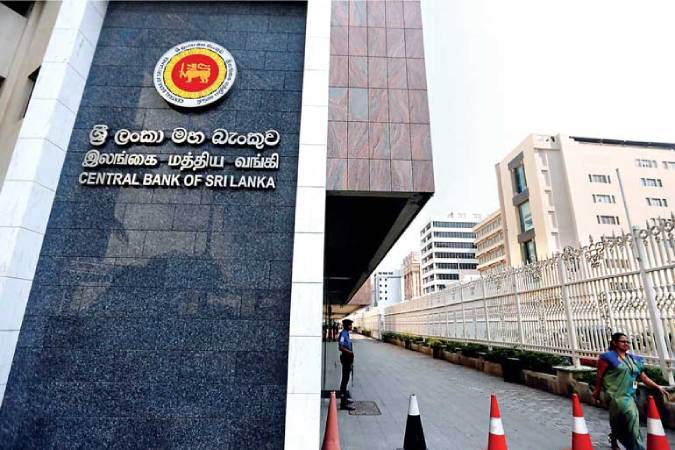Central Bank Governor Dr. Nandalal Weerasinghe gestures during the media briefing last week following the October Monetary Policy Review.
Warns soaring inflation worst enemy for economic stability and high cost of production, hence it must be addressed first
Justifies tight monetary conditions; says high interest rates essential to reduce present high inflation
Opines lowering interest rates now could delay disinflation process and would require a larger and more painful upward adjustment in interest rates once again later
Dismisses perception that reduction in interest rates will help business and households
Argues delay in disinflation process will prolong and aggravate hardships for all segments of economy
Alleges Monetary Policy by previous administration focused on Govt. interest and not that of the people nor addressed country challenges, forcing excessive money printing
Assures disinflation path from November and interest rates will be normalised once price stability is restored
By Nisthar Cassim
The Central Bank last week implied that high inflation was the mother of all economic evils, hence it must be dealt with first if the country was to ensure stability followed by growth.
Due to multiple factors inflation has seen a phenomenal rise this year with 64.3% in September and more worrisome food inflation peaked to 95% as per the Colombo Consumer Price Index (CCPI). As per the National Consumer Price Index (NCPI) which captures a lagged effect, inflation in August was 70.2% and food inflation was 85%.
The Central Bank on Thursday following the Monetary Policy review said the rise in headline inflation was driven mainly by the recent revision of electricity and water tariffs and the increase in Value Added Tax (VAT).
“However, headline inflation is expected to follow a disinflation path in the period ahead,” it added. CBSL also said subdued aggregate demand pressures resulting from tight monetary and fiscal conditions, expected improvements in domestic supply conditions, normalisation in global food and other commodity prices, and the timely passthrough of such reductions to domestic prices, along with the favourable statistical base effect, will be instrumental in bringing down inflation over the medium term.
“We expect inflation to peak in October and decelerate thereafter,” CBSL Governor Dr. Nandalal Weerasinghe told journalists. He spoke of a disinflation path from the fourth quarter of 2022 and a more pronounced trajectory in the first quarter of 2023.
He emphasised that high inflation was the worst enemy for economic stability and high cost of production hence it must be addressed first.
Tackling soaring inflation as a priority and in the process keeping interest rates at relatively higher level has sparked criticism against the CBSL from certain sections of the Government, policy advisors and the business community especially the small and medium enterprise sector.
Average Weighted Prime Lending Rate (AWPR) last week was 26.70% as against 6.7% a year ago. Average Weighted Lending Rate was near 17% as against 9% last year and Average Weighted New Lending Rate was 24% as against 8%.
Though acknowledging there is a perception that reduction in interest rates will help business and households, the CBSL said the Monetary Board is of the view that to reduce the present high inflation, tight monetary conditions in terms of high interest rates are essential. “Lowering interest rates now could delay the disinflation process which would require a larger and more painful upward adjustment in interest rates once again,” CBSL warned.
It said hardships faced by the people and businesses during the disinflation process are expected to be temporary but any delay in the disinflation process will prolong and aggravate these hardships for all segments of the economy. Interest rates will be normalised once price stability is restored, emphasised the CBSL.
Governor Dr. Weerasinghe also dismissed the notion that high interest rates are driving costs saying high inflation was the cause. “Finance cost is only 10% of the cost and inflation influences the balance 90%,” he said.
The CBSL Chief also faulted the previous administrations for artificially keeping interest rates low amidst relatively low Government income thereby being forced to resort to excessive money printing. “In the past Monetary Policy focussed on the Government interest and not that of the country. Today we have to do what is right by the people and country challenges,” Dr. Weerasinghe stressed.
Last week the Monetary Board of the Central Bank kept policy rates unchanged after assessing the current and expected macroeconomic developments. Policy rates were last revised in July by 100 basis points – Standing Deposit Facility Rate to 14.50% (5% a year ago) and Standing Lending Facility Rate to 15.50% (6% a year ago) whilst in April the tightest action came with a 700 basis points increase doubling the rates.
The Monetary Board was also of the view that the recently introduced tight fiscal policy measures would also help curtail any further build-up of demand pressures in the economy, complementing the effects of tight monetary policy already in place.
FT

